“Why Inclusion Matters”: GM’s Stephanie Thompson on STEM, Women in Manufacturing
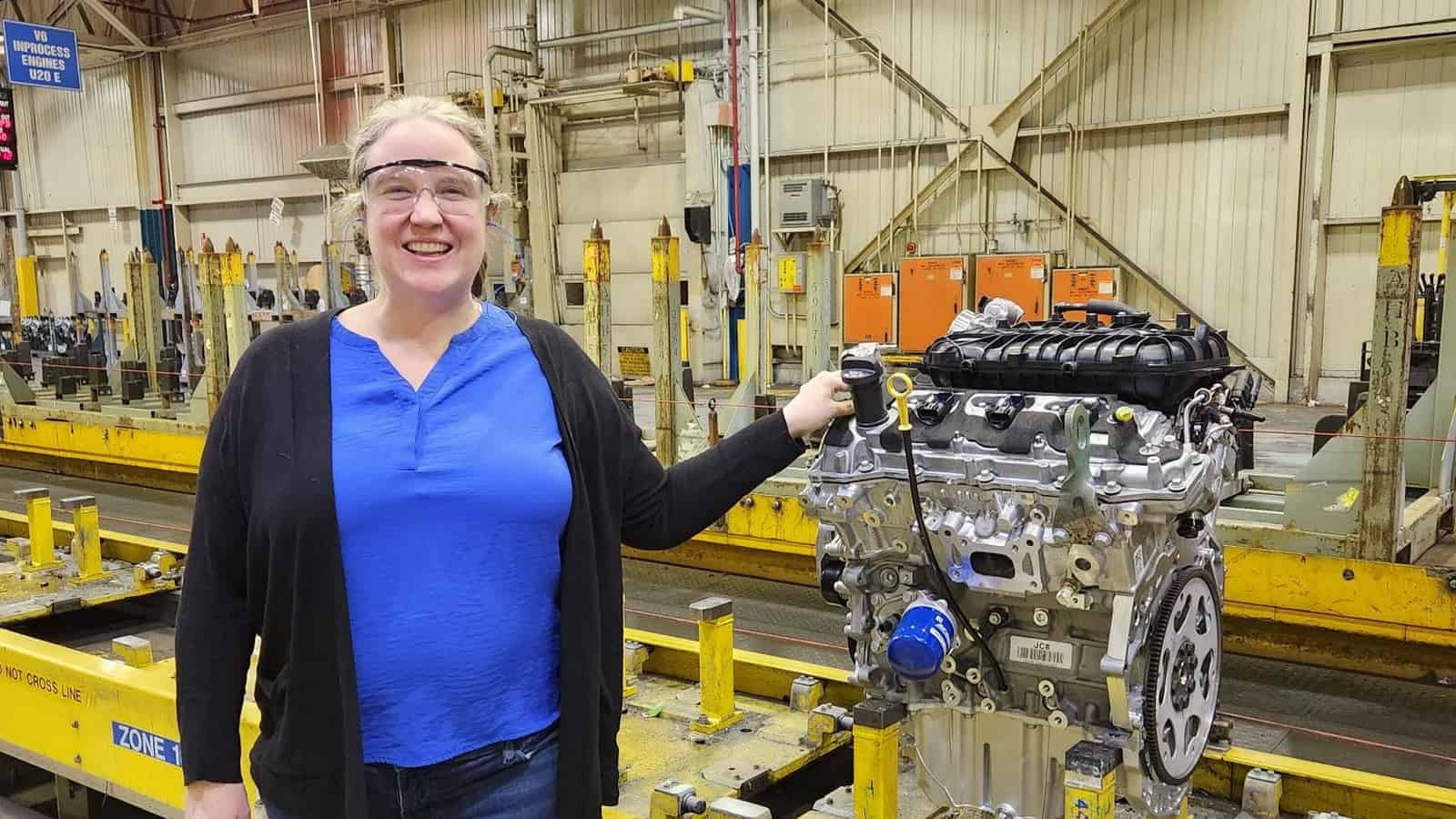
Stephanie Thompson may not have always intended to go into manufacturing, but she’s very glad she did.
The path taken: “You don’t necessarily plan your journey, but sometimes you can look back and see how those paths presented themselves,” and you’re thankful they did, said the engineering manager at General Motors’ facility just outside St. Catharines, Ontario, Canada.
- “My career in manufacturing started in internships in university. I worked for a food manufacturer, for a company that made above-ground swimming pools … It was a great chance to try out different businesses, and I [realized that I] love the buzz and excitement that manufacturing has.”
Award nominee: Thompson is a 2024 Honoree of the Women MAKE Awards, honors given annually to 130 women making a difference in manufacturing by the Manufacturing Institute, the NAM’s 501(c)3 workforce development and education affiliate.
- Thompson—who started working for GM full time right after university and has held multiple positions in her 23 years there—was the first woman to become an engineering manager in her time at her site.
- Women MAKE Award winners will be celebrated April 18 at the 2024 Women MAKE Awards Gala in Washington, D.C.
Always improving: An Ottawa native and graduate of the University of Waterloo, Thompson sums up her very complex job as “a manufacturing assembly specialist [who] makes sure people can do their jobs safely—and do it over and over again.”
- She oversees the assembly of whole powertrain lines. For one particular engine, “I was there for the first one made, and I was here for the last—we made over 5 million,” she said of a recently retired line.
- “We are always looking to make improvements, to make things more cost effective, to make things simpler,” she said. “The problem-solver part of me really enjoys making those incremental differences every day. [In manufacturing,] you get that sense of satisfaction from making stuff and ultimately giving a customer what they want.”
Women in STEM: Thompson, who has been recognized several times in her native Can
ada for her commitment to women’s education in science, technology, engineering and math, somehow found the time a few years ago to launch STEMbySteph.com, a STEM-focused website that includes a workshop series for women in the fields.
- She is also a mentor for FIRST Canada, which aims to interest kids in science and technology, and a regular speaker on related topics.
- “There are so many great women coming up through the ranks” in manufacturing today, she told us. “I want them to know there isn’t a limit to what they can do. I want to put myself out there as a technical role model, so women who apply [for manufacturing and STEM jobs] see themselves on the interview panel. They should know there’s a space for them in manufacturing.”
Work in progress: And while she’s had “nothing but great experiences with the men in manufacturing,” Thompson said the industry as a whole could benefit from “having some conversations” to make sure women feel welcome.
- “I don’t think it’s malicious,” she said, of the relatively low number of women in manufacturing (they make up about 30% of the
manufacturing workforce). “But one of the things you have to do as a leader is create intentionality and create environments where conflict is positive, where you can all create ideas to [fix] the problem and where individuals feel safe being themselves.”
Study: Manufacturing in U.S. Could Need Up to 3.8 Million Workers
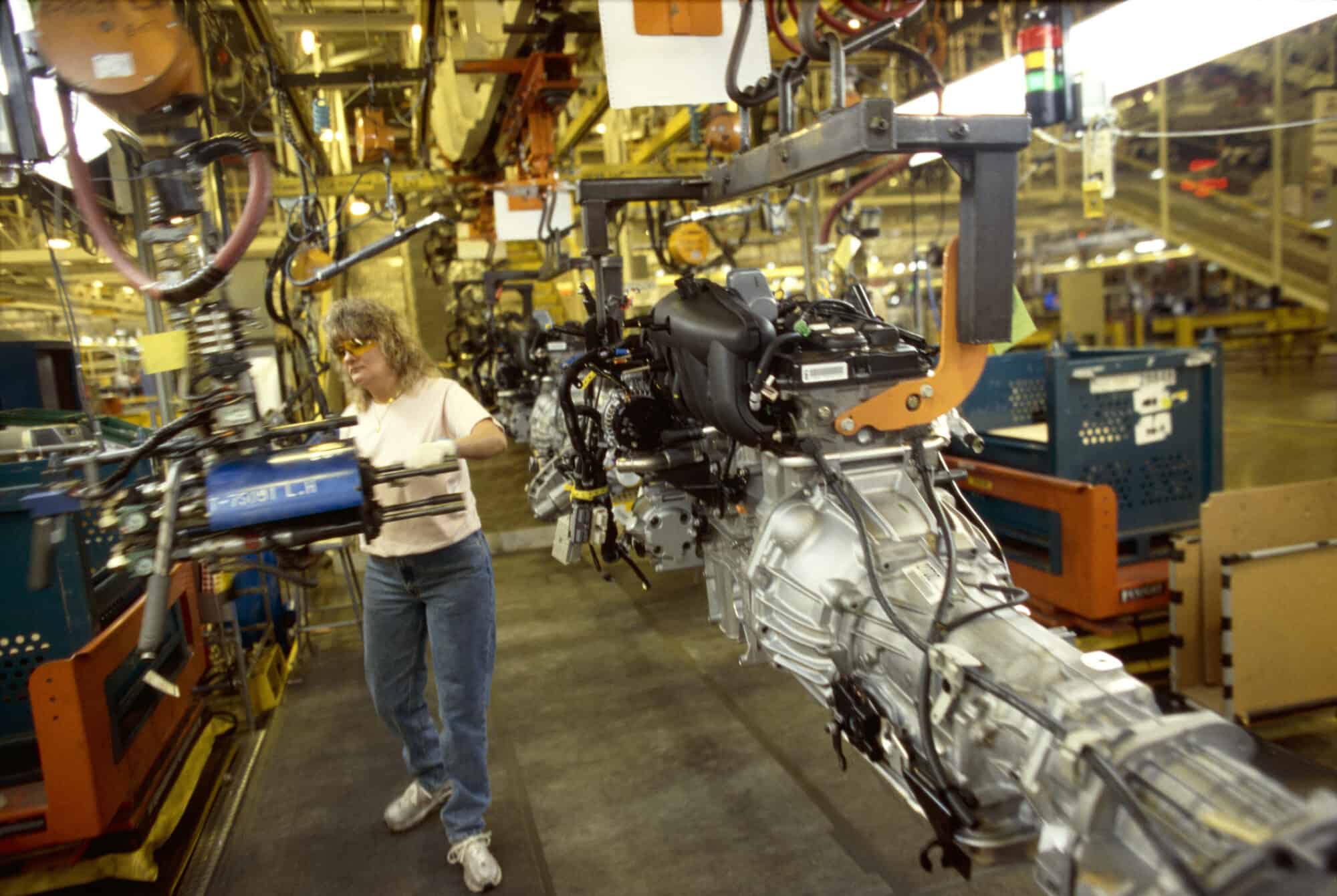
The U.S. manufacturing industry could require some 3.8 million jobs to be filled within the next decade, according to a new joint study from the Manufacturing Institute, the NAM’s 501c3 workforce development and education affiliate, and Deloitte.
What’s going on: “Taking charge: Manufacturers support growth with active workforce strategies” found that manufacturing in the U.S. has emerged from the global pandemic on strong footing and is likely to continue to grow in the next few years.
- That growth will call for even more skilled workers—particularly statisticians, data scientists, logisticians, engineers, computer and information systems managers, software developers and industrial maintenance technicians—spotlighting the need to build the national talent pipeline.
- “Pandemic-driven shifts have already created hundreds of thousands of new jobs, and now we are seeing increased demand for digital skills that need to be met or risk further widening of the talent gap,” said Manufacturing Institute President and Executive Director Carolyn Lee.
Key findings: Top takeaways from the report include:
- If workforce challenges are not addressed, more than 1.9 million of the up to 3.8 million jobs likely to be needed between this year and 2033 could go unfilled.
- Some 65% of manufacturers polled said attracting and retaining talent is their primary business challenge.
- About 90% said they are forming at least one partnership to better attract and retain employees, and on average they have at least four such partnerships.
- Approximately 47% indicated that apprenticeships, work study programs or internships at manufacturing companies would be the most effective way of increasing interest in the industry.
- Some 47% also said flexible work arrangements—such as flex shifts, shift swapping and split shifts—have been their top retention tool.
The bottom line: Manufacturers continue to face a talent shortage—and the MI has the initiatives and resources ready today to help manufacturers address these challenges.
- From the recent flexibility white paper—which explains how manufacturers can build and deploy flexibility options for the 49% of workers that are on the production teams—to the high school internship toolkit that allows manufacturers to start a recruiting pipeline in high schools, to the FAME USA apprenticeship program training global best multi-skilled maintenance technicians and more, the MI has solutions to the hurdles highlighted in this study. Learn more at themanufacturinginstitute.org.
How Pioneer Service Solves the Retention Puzzle
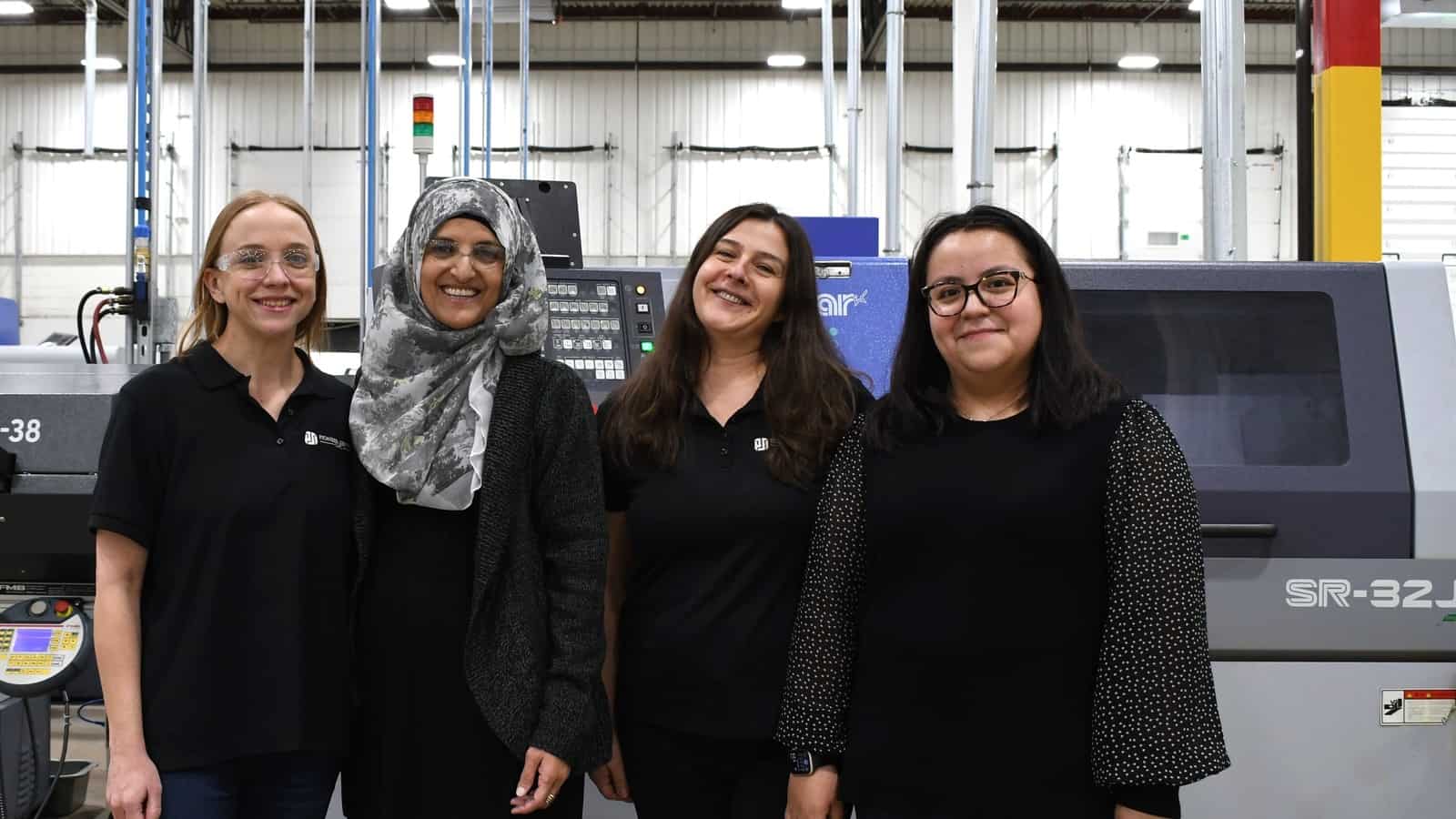
For Pioneer Service President and Co-Owner Aneesa Muthana, having an engaged team is the key to solving the workforce retention puzzle. The Addison, Illinois–based, woman-owned company is among the many manufacturers that find retention, along with recruitment, to be top business challenges, as the NAM’s Manufacturers’ Outlook Survey shows. So how has Muthana gone about building such a team?
Where it all starts: For Muthana, meeting this challenge begins with upholding the company’s core values: integrity, diversity, leadership, outreach, stewardship, quality and learning.
- These words appear on the shop floor, and every job candidate who comes in for an interview receives a handout outlining their importance. “These are more than just pretty words on a wall,” said Muthana. “We chose these values as a team because they pinpoint our path to success, both financially and ethically.”
- “I give them a copy because I want them to understand the importance from the beginning,” said Muthana. “We want to plant the seed before they’re on our payroll that these are the expectations. Then it becomes fair to hold people accountable to them.”
Providing training opportunities: In keeping with its core values of stewardship and learning, Pioneer Service offers internal training opportunities for employees who express an interest.
- “We offer training to anyone who raises their hand, whether it be in safety or leadership,” said Muthana. “It can also be very technical training on the shop floor. We also provide GD&T training, including for our sales team.”
- GD&T, or geometric dimensioning and tolerancing, determines how parts fit together into an assembly to form a product.
- The benefit of having a salesperson learn about GD&T? “A salesperson would be able to look at a customer print confidently and feel comfortable talking to the customer without needing to have an engineer in the room,” Muthana pointed out.
Offering support: Pioneer Service established a chaplaincy program, which connects employees and their families undergoing hardships—such as caring for an elderly parent, grieving the loss of a loved one or dealing with a personal struggle—with a chaplain who can provide counseling and offer spiritual and emotional support. Muthana says that the chaplaincy program is open to any employee, regardless of religious background or preference.
- “The chaplain service is part of our team,” said Muthana. “We have one chaplain come in every week—one week a male and then the following week a female—who is available to meet with staff if needed.”
- Muthana says she used the service a few years ago when her son, who is in the military, came back from Afghanistan. Many of his friends did not.
- “As a parent, you feel grateful that your child survived, but also guilty for feeling that way because a lot of his friends didn’t come home. The chaplain service provided me someone to talk to because I couldn’t talk to my family, and I couldn’t talk to my staff,” she recalls. “I developed a strong relationship with the chaplain that I feel never would have happened if I didn’t look out for my staff and implemented the service.”
Job shadowing: When Muthana goes to a speaking event or conference, she sometimes takes one or two of her staff with her so they’re able to benefit from attending. It’s also a way for her to get to know her staff on a more personal level, outside of the formal workplace setting.
The last word: Muthana shared some advice for companies struggling with workforce retention:
- “Having an engaged team and workers only happens with a people-first mentality,” said Muthana. “When you take care of them, you become successful because you have an engaged team that has your back.”
- “It’s harder to make a profit than ever. The only way that we’re going to be successful is by having an engaged team.”
Go deeper: The Manufacturing Institute (the NAM’s workforce development and education affiliate) has many resources to help employers retain and develop their teams.
- Start with this study to learn how to build positive company culture and engage employees, explore strategies in boosting retention and employee engagement, delve into tips on attracting and retaining talent in rural vs. urban settings and check out the MI’s recent white paper on flexibility approaches for manufacturing production workers, a key tool to improving the employee experience.
- Pioneer Service’s approach to workplace needs exemplifies the benefits of focusing on the holistic frontline employee experience, which include higher retention, less absenteeism and greater engagement, according to a study conducted by the MI and PwC.
- Learn more about Women MAKE America and the 35×30 campaign, the MI’s initiatives to increase the number of women in manufacturing, tapping into this population to address persistent workforce shortages. Military-affiliated talent and second chance populations are great sources, too.
Three Sisters Build Manufacturing Careers Together
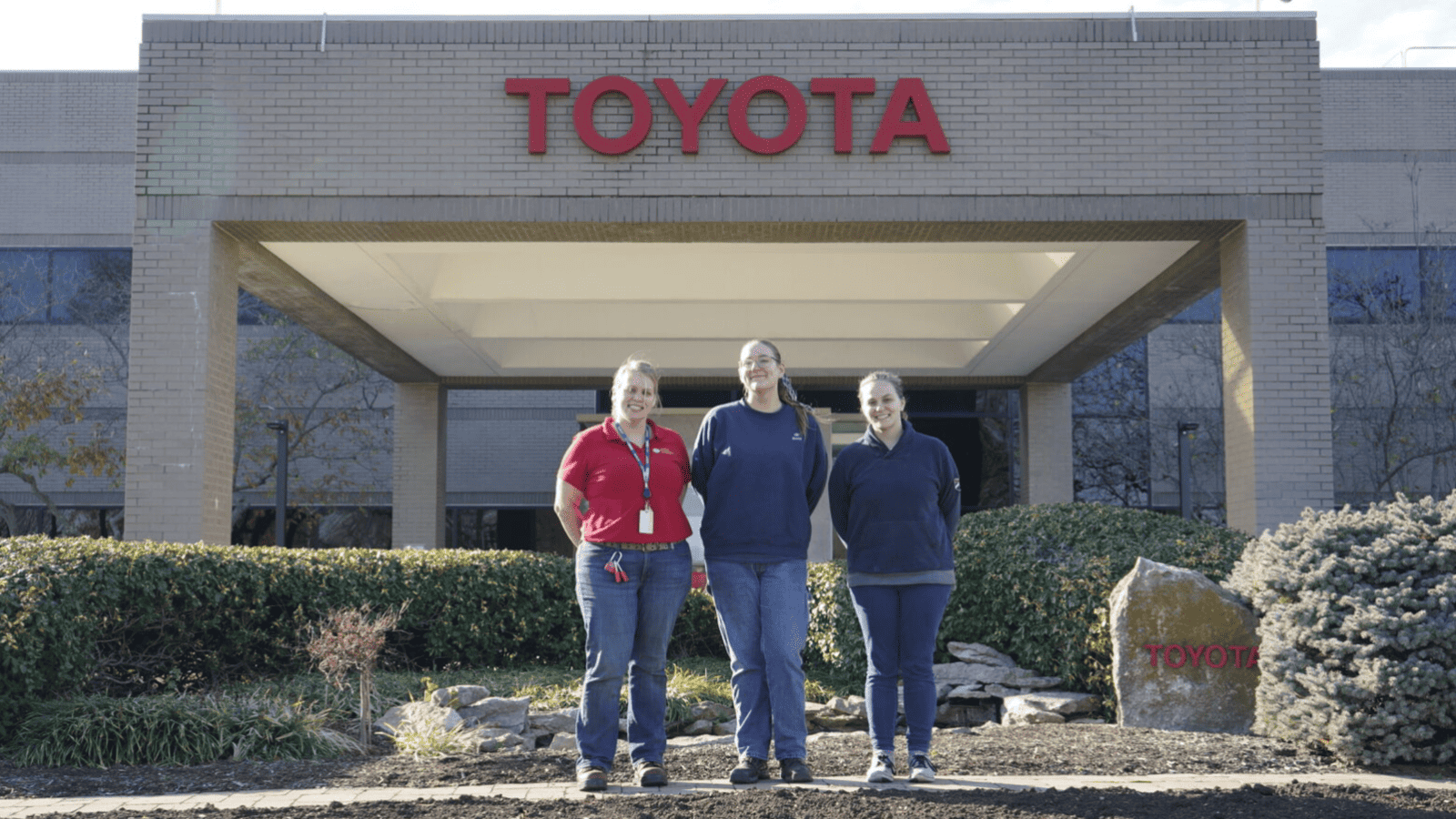
For three sisters in Kentucky, manufacturing is a family affair.
Emily Bastin, Heather Craven and Hannah Geneve are all working in maintenance roles supporting various shops at Toyota Motor Manufacturing Kentucky. Growing up, they had disparate interests—while Emily had taken robotics classes in middle school and Heather had always enjoyed working with her hands, Hannah switched to manufacturing only after working in customer service. Today, all three of them are building careers in manufacturing together.
How they got here: Emily, Heather and Hannah found their way into manufacturing through FAME—an initiative for current and aspiring manufacturing workers that was founded by Toyota in 2010 and is operated today by the Manufacturing Institute, the NAM’s workforce development and education affiliate.
- The FAME Advanced Manufacturing Technician program offers on-the-job training and classroom education that combine technical training with professional practices and lean learnings to create world-class technicians. The two-year AMT program leads to an associate degree and the FAME certificate.
- “They came to my school—the AMT program—and I was like, you know, let’s give this a shot,” said Emily. “I didn’t realize I would have that kind of potential. This was cool stuff.”
The family business: Emily was the first of the three sisters to graduate from FAME, and she has been helping her sisters as they work their way through the program. Both Hannah and Heather are enrolled in FAME while working at Toyota, and they expect to graduate in May 2025.
- “We’re all working in the same plant, and if they need anything from me, I’m there to be supportive,” said Emily.
- “With schoolwork, I try to help Heather, and she tries to help me,” said Hannah. “We all help where we can.”
- “It’s nice to have that sister love to lean on,” said Heather. “They understand the frustration of school and work, and it’s been a pleasure to work with them.”
Opportunities abound: The sisters advise others who might not have considered manufacturing as a career—especially women—to give the industry a second look, emphasizing the sheer diversity of jobs on offer.
- “Working in manufacturing doesn’t necessarily mean you’re working on a factory floor,” said Hannah. “There’s an administrative side, an HR side—there’s a lot more to manufacturing than people expect.”
- “I do see us being examples for women who might not normally see themselves in the field,” said Heather. “You want to see women come in and say, hey, I did it, and you can, too. It’s nice to see yourself reflected back.”
The community: It’s not just their family ties that keep the sisters in manufacturing. All three sisters have high praise for their fellow students and colleagues, and for the supportive culture they’ve encountered at Toyota.
- “The mentorship I got helped me gain my confidence while I was learning,” said Emily. “And even now, the teamwork that goes into everything, every day—it’s been a nice surprise.”
- “Everyone has been super nice, super helpful and super welcoming,” said Hannah. “When you start out, it can seem intimidating, but everyone’s willing to help you out. They really want you to succeed.”
The last word: “It’s nice to feel like you’re a part of that network—that family,” said Heather.
The MI’s 35×30 campaign aims to increase the share of women in manufacturing to 35% by 2030 and spotlights outstanding women in the industry like these sisters. To learn more about Women MAKE America and explore its many opportunities, including its new mentorship program, go here.
The Federation for Advanced Manufacturing Education provides global-best workforce development through strong technical training, integration of manufacturing core competencies, intensive professional practices and intentional hands-on experience to build the future of the modern manufacturing industry. Learn more here.
How One Manufacturer Is Building a Local Talent Pipeline

The president of Connecticut-based outdoor lighting manufacturer Penn Globe recently oversaw the launch of a long-awaited passion project: the Manufacturing and Technical Community Hub, or MATCH, a New Haven, Connecticut–area nonprofit contract manufacturing organization and training program designed to fill job openings in the sector.
Seeing a need: “I am a manufacturer, and one of the things I saw missing from the various workforce training programs available was the manufacturers themselves,” LaFemina said. “They weren’t reaching [the participants] in these training programs. So I was a bit frustrated, but that frustration was good … because it led us to create a program with manufacturers training people for actual manufacturing jobs.”
- In 2021, LaFemina and MATCH co-founder Lindy Lee Gold, senior regional manager of the Connecticut Department of Economic and Community Development, secured funding from partners including Lee’s agency, the city of New Haven, the Connecticut Department of Labor and numerous nonprofits.
- This past June, after LaFemina—now MATCH board chair—and the rest of the organization’s board of directors signed a lease on a building, MATCH was born.
How it works: MATCH begins with a two-week, earn-as-you-learn program, offered in both English and Spanish.
- The organization offers training in everything from basic welding to CNC machining, allowing participants to choose the type of manufacturing that interests them most.
- Then, depending on the complexity of their chosen specialty, they may spend up to six additional weeks in paid, on-the-job training before being placed in jobs with local manufacturers.
Meeting the moment: Unlike job-training offerings that expect a certain level of familiarity with an industry, MATCH starts from scratch.
- “Some places say, ‘Let’s test you on something you know nothing about,’” LaFemina told us. “We want to meet the moment. … We’re asking you to come in, give us two weeks and we will pay you minimum wage for the time that you’re here learning.”
- “We’ll figure out what you like and what you’re good at, and as long as we have the workload to make things, you’ll have a job,” she continued.
Being accessible: MATCH also prides itself on seeking out potential employees, instead of waiting to be found.
- “We wanted a building in a specific neighborhood in New Haven,” LaFemina said. “It’s where the majority of the social agencies are, the immigration services, the reentry services. I’d been hearing for two years about how people have [training] programs but couldn’t get participants because [the program locations] were difficult to get to. This one isn’t.”
Family friendly: One of MATCH’s main goals is to reach parents, many of them women, who have left the workforce due to difficulty securing child care. The program’s core hours are 9:00 a.m. to 2:00 p.m., Monday through Friday, in sync with those of most schools.
- MATCH partners are already considering using the program’s New Haven facility as a training site for day care providers, to help alleviate the shortage of workers in that sector.
- In addition, the program’s first cohort of students came from the New Haven Healthy Start’s Fatherhood Involvement project, one of several local initiatives with which the organization has ongoing relationships.
What’s next: MATCH is on track to be financially self-sustaining in three to five years—and LaFemina predicts big growth after that.
- “I see multiple MATCHes down the road,” she said. “There’s already a call for more. My biggest goal is in a few years all of us older people, who leveraged our connections to make this happen, will turn it over to a younger group that will turn it into something even better than it already is.”
Creators Wanted and Union Pacific Dazzle the Twin Cities
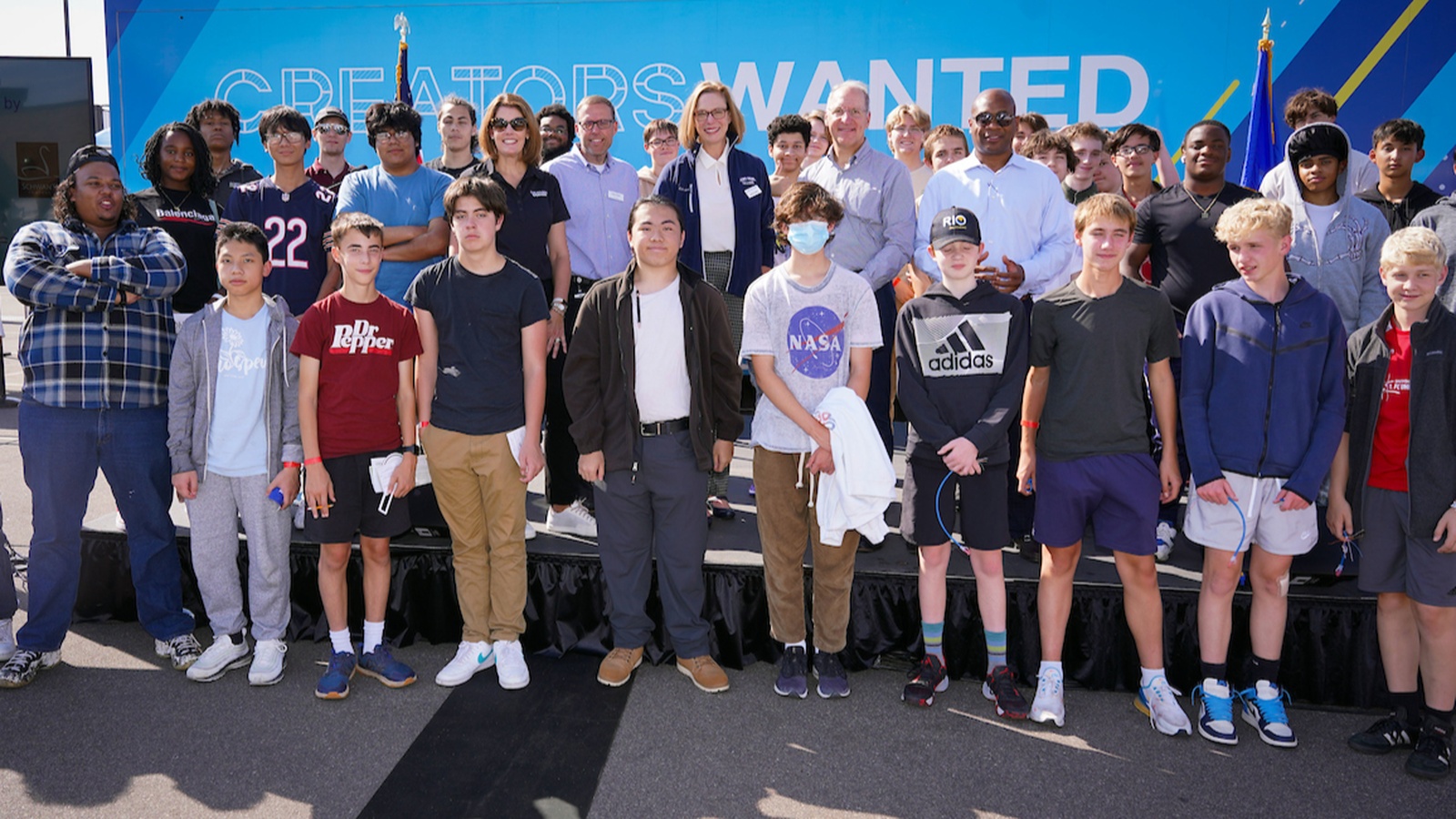
Last week, Saint Paul College in St. Paul, Minnesota, which boasts a student body that is 65% people of color, became the 19th stop of 20 for the Creators Wanted Tour, a joint project of the NAM and the Manufacturing Institute, the workforce development and education affiliate of the NAM.
Over three days, with Union Pacific as the lead sponsor, the stop drew more than 600 visitors, from students to educators. Meanwhile, 42,000 online signups in Minnesota helped the campaign surpass 1.5 million nationwide from students and career mentors interested in modern manufacturing careers.
Twin Cities kickoff: Union Pacific Executive Vice President of Marketing and Sales Kenny Rocker gave the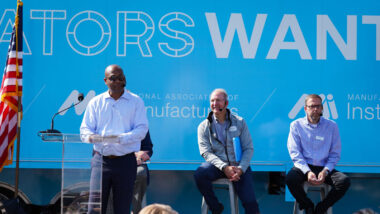 keynote address at the kickoff event, emphasizing the reward of manufacturing careers. He was joined by MI President and Executive Director Carolyn Lee, Saint Paul College President Dr. Dee Dee Peaslee, Minnesota Chamber of Commerce President and CEO Doug Loon and Trane Technologies Vice President of Product Management Dave Molin.
keynote address at the kickoff event, emphasizing the reward of manufacturing careers. He was joined by MI President and Executive Director Carolyn Lee, Saint Paul College President Dr. Dee Dee Peaslee, Minnesota Chamber of Commerce President and CEO Doug Loon and Trane Technologies Vice President of Product Management Dave Molin.
- “When I talk about opportunities, I’m talking about really good-paying jobs … At Union Pacific, we’re talking jobs that are … averaging over $100,000 a year, and that’s without benefits, and so you just really have an opportunity to make an impact from that perspective,” said Rocker.
- “At Trane Technologies, our vision is to boldly challenge what’s possible for a sustainable world,” added Molin. “It is the engine of our company, and we live it every day. And to do that, we need bright minds and the best minds in the world. We need diverse thinkers, we need creators, and our doors are open to everyone.”
- Notably, leaders from key government business and workforce partner organizations attended the kickoff, including the Minnesota State Advanced Manufacturing Center of Excellence, Minnesota Black Chamber of Commerce, Minnesota Parent Union and St. Paul Area Chamber, representatives from the offices of U.S. Reps. Brad Finstad (R-MN-1), Angie Craig (D-MN-2), Dean Phillips (D-MN-3), Betty McCollum (D-MN-4) and Michelle Fischbach (R-MN-7), Mayor of South St. Paul Jimmy Francis and State Reps. Jon Koznick (R), Emma Greenman (D) and Samantha Sencer-Mura (D).
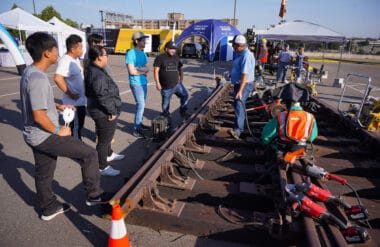
Experience and exploration: Students delved deep into immersive activities, from solving manufacturing-related puzzles in the Creators Wanted mobile experience to virtually navigating a locomotive through Union Pacific’s simulators. Equally captivating was the sight of the actual railroad track, which was complemented by insightful career anecdotes from Union Pacific professionals.
- Eighty-seven percent of students surveyed reported a significantly improved view of modern manufacturing careers after completing the immersive experience.
Live Q&A sessions: The stop also offered structured opportunities for students to learn about manufacturing organizations’ support for the next generation of talent, along with the importance of mentorship and personal development in shaping successful careers.
- The first session, featuring two Union Pacific senior managers—Amy Bang, Sr. manager of diversity and inclusion, and Ken Kuwamura, Jr., manager of talent acquisition—and Saint Paul College instructors, zeroed in on the crucial roles of mentorship, diversity and passion in career selection.
- The second session, with Jake Yernberg, automotive instructor, Saint Paul College; Caitlin Bundy, manager of corporate sustainability, Union Pacific; and Preeti Subramanian, senior product manager, Trane Technologies, accentuated the pivotal role of manufacturing in tackling global challenges. Panelists pointed out the advantages of the manufacturing sector, citing competitive pay and the sector’s potential in addressing global issues, such as sustainability and climate change.
Interactive Learning: Everfi®, Ecolab and Schwan’s joined Union Pacific in bringing in representatives to give students career advice—and offer activities to spark their curiosity.
- Everfi® showcased a new digital education program, “Future Creators,” co-developed with the MI and Union Pacific, to give middle and high school students a peek into STEM careers.
- Saint Paul College also took students on a tour of its robust Trades and Technical Education program.
Beyond the Tour: The Twin Cities event is a part of Union Pacific’s overarching “Careers on Track” initiative, which aims to inspire more women and youth to pursue modern industrial careers, and the Creators Wanted campaign’s sustained drive to enhance perceptions of manufacturing careers in the United States and empower more people to create the future.
The last word: “I want all of you out here, the students, to have an opportunity to go out there and win and compete and further your careers and do well in life,” said Rocker, echoing a theme the Creators Wanted Tour has promoted since its inception: manufacturers and manufacturing care about students and their future.
Next up: The pioneering Creators Wanted Tour concludes next month, Oct. 17–21, at the Circleville Pumpkin Show in Circleville, Ohio.
Manufacturers: Impact of Strike Will Echo Far Beyond Detroit
Washington, D.C. – National Association of Manufacturers President and CEO Jay Timmons released the following statement on the United Auto Workers’ announcement to start a “Stand Up” strike:
“The impact of this strike will echo far beyond the city of Detroit as multiple economic analyses have demonstrated. The small and medium-sized manufacturers across the country that make up the automotive sector’s integrated supply chain will feel the brunt of this work stoppage, whether they are a union shop or not.
“American families are already feeling economic pressures from near-record high inflation and this will only inflict more pain. We urge a swift resolution to end this strike and avoid further undermining the strength of our industry and harming our broader economy.”
-NAM-
The National Association of Manufacturers is the largest manufacturing association in the United States, representing small and large manufacturers in every industrial sector and in all 50 states. Manufacturing employs nearly 13 million men and women, contributes $2.91 trillion to the U.S. economy annually and accounts for 55% of private-sector research and development. The NAM is the powerful voice of the manufacturing community and the leading advocate for a policy agenda that helps manufacturers compete in the global economy and create jobs across the United States. For more information about the NAM or to follow us on Twitter and Facebook, please visit www.nam.org.
Overregulation and Workforce Challenges Weigh Heavily on Manufacturing Sector
Optimism Sinks to Pandemic Lows in Q3 Outlook Survey
Washington, D.C. – The National Association of Manufacturers released its Manufacturers’ Outlook Survey for the third quarter of 2023, which registered the lowest level of optimism among NAM members (65.1%) since Q2 2020, as the sector continues to confront a tight labor market, unbalanced federal regulations and critical policy debates in Congress.
“Manufacturers continue to be challenged in today’s economy, but what this survey makes clear is that unbalanced federal regulations are harming families and communities, with nearly two out of three manufacturers reporting that the regulatory burden is preventing them from hiring more workers or increasing pay and benefits,” said NAM President and CEO Jay Timmons. “Congress and the administration can help correct this trend by restoring sensible regulations, enacting further permitting reforms, taking action to keep our tax code competitive and other bipartisan steps to strengthen manufacturing in America and build on the progress we achieved with tax reform, the Bipartisan Infrastructure Law, the CHIPS and Science Act and more.”
Key Survey Findings:
- Only 65.1% of respondents felt positive in their company’s outlook, edging down from 67.0% in the second quarter. It was the fourth straight reading below the historical average (74.9%).
- Concern about an unfavorable business climate was the highest in six years (Q2 2017).
- The survey found that 69.1% of small manufacturers, and 63.2% of all respondents, would hire more workers or increase compensation if the regulatory burden decreased.
- More than 70% of manufacturers would purchase more capital equipment if the regulatory burden on manufacturers decreased, with 48.6% increasing compensation, 48.6% hiring more workers, 42.5% expanding their U.S. facilities and 38.4% investing in research.
- The top challenges facing manufacturers include attracting and retaining a quality workforce (72.1%), weaker domestic economy (60.7%), rising health care/insurance costs (60.1%), unfavorable business climate (56.7%), increased raw material costs (45.5%) and supply chain challenges (37.8%).
You can learn more at the NAM’s online regulatory action center here.
The NAM releases these results to the public each quarter. Further information on the survey is available here.
-NAM-
The National Association of Manufacturers is the largest manufacturing association in the United States, representing small and large manufacturers in every industrial sector and in all 50 states. Manufacturing employs nearly 13 million men and women, contributes $2.91 trillion to the U.S. economy annually and accounts for 55% of private-sector research and development. The NAM is the powerful voice of the manufacturing community and the leading advocate for a policy agenda that helps manufacturers compete in the global economy and create jobs across the United States. For more information about the NAM or to follow us on Twitter and Facebook, please visit www.nam.org.
How Manufacturers Can Tap into a Large, Talented Workforce
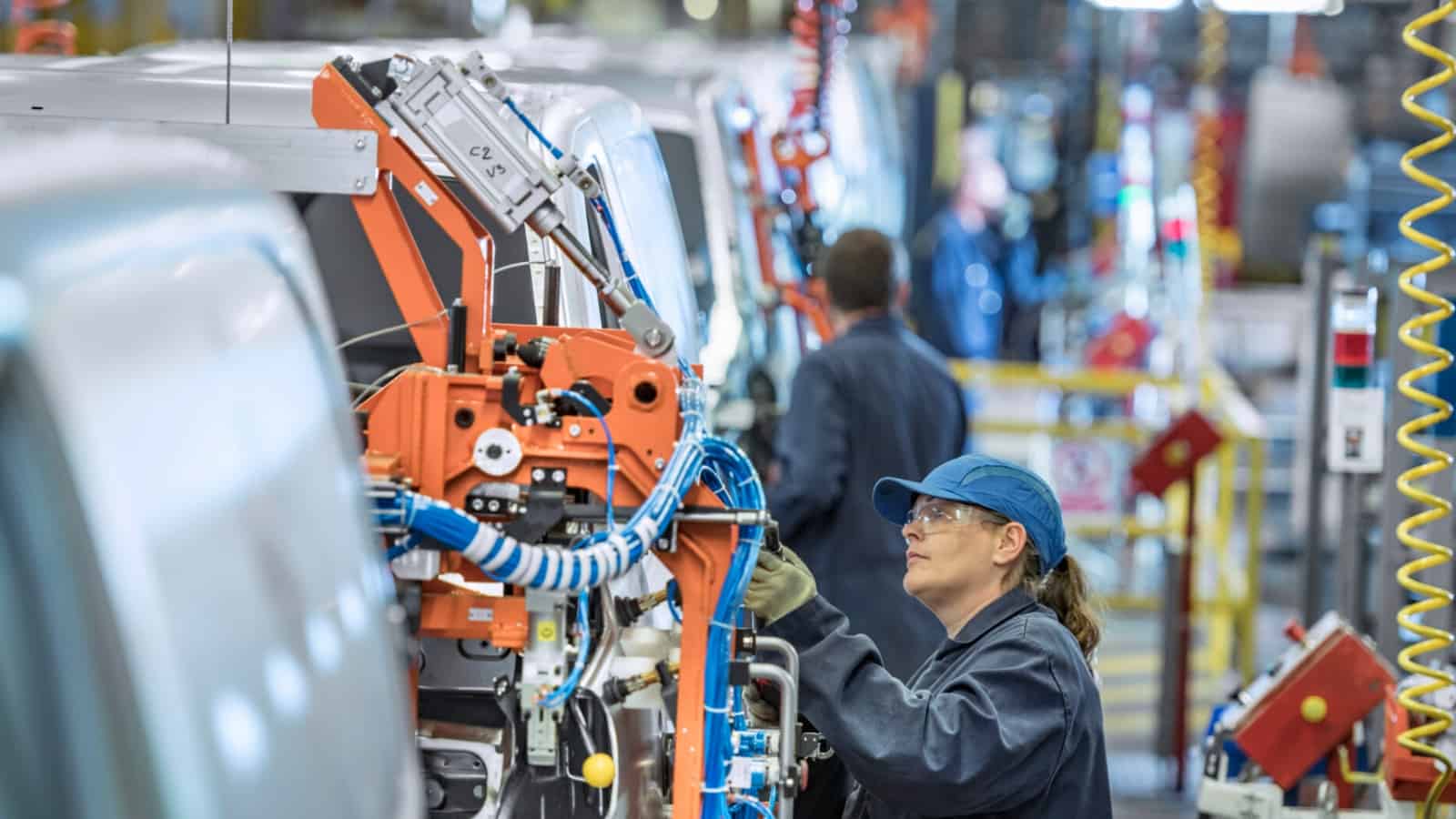
Discipline, reliability, a team-player mindset, leadership—manufacturers are looking for all these qualities in the talent they recruit. What if companies could tap into a population not only equipped with these skills but experienced in using them in high-stakes situations?
Well, the Manufacturing Institute—the workforce development and education affiliate of the NAM—has good news, if you haven’t heard it already: this population exists, and it’s military talent. Transitioning service members, veterans, National Guard members, reservists and military spouses have a wealth of skills and experience that translate easily into a manufacturing context.
So how can manufacturers reach these workers and make the best use of them? The MI recently convened both military and manufacturing leaders in Fayetteville, North Carolina, for its third Workforce Solution Series event, where they answered this question and offered a range of useful advice. Here are some of the highlights.
Generally speaking: Major General Eugene J. LeBoeuf, Deputy Commanding General, U.S. Army Reserve Command, highlighted the talents and skillsets that Army reservists can offer the manufacturing industry, including agility, a can-do attitude and a thorough grounding in engineering, logistics and mechatronics.
- With nearly 190,000 soldiers, the Army Reserve comprises much of the readiness force of the U.S. Army. Many of these reservists are underemployed or unemployed, which means they represent an opportunity for manufacturers.
- Manufacturers interested in hiring from this labor pool can partner with the Private Public Partnership Office, which connects companies with reservists at no cost.
Reaching military talent: Several panelists emphasized the importance of developing recruitment processes that encourage military talent to apply and interview for manufacturing jobs.
- “Make sure that the requirements you’re listing in your position descriptions are actually required. Do you really need someone to have a master’s degree to get the job done?” asked Rob Patton, vice president of Fayetteville Cumberland Economic Development Corporation.
- As a recently transitioned service member, James Goppert, HR business partner at WestRock, explained some of the challenges that military talent may face when entering the workforce. “Having to explain military skills and certifications to a civilian in an interview was strange. It would have been helpful to have someone on the other side who understood my experiences.”
Open to all possibilities: Jennifer Goodman, senior manager of talent initiatives at Coca-Cola Consolidated, drew on her experiences as a military spouse. “Military spouses are 92% women and have a 22% unemployment rate. That’s a huge labor pool that’s going underemployed or unemployed.”
- While relocation is often a concern for companies, Goodman points out that it does not have to be a disadvantage. “Think of manufacturers who have locations across the country. Maybe you can start a military spouse at one location and then move them to another. Or, if they’ve proven themselves after a few years, you could transition them to remote work.”
- “The benefits don’t stop with the one military spouse you hire,” she added. “We’re a very loyal community with great word of mouth and a larger referral network.”
The last word: “Don’t underestimate the value of an event like this Solution Series can have. You can take the information, energy and passion that you get from meeting with people who have the same goal of building a stronger economy and use it to power you forward,” said Nathan Huret, economic development director for Catawba County.
Learn more: To get started—or continue—with hiring military talent, check out the extensive resources of the MI’s Heroes MAKE America initiative, which prepares prospective military workers for new and rewarding careers in manufacturing.
Largest Manufacturing Campaign in the Nation, Creators Wanted, Arrives at the Indianapolis Motor Speedway
Indianapolis, Indiana – The National Association of Manufacturers, the Manufacturing Institute, the workforce development and education affiliate of the NAM, and Snap-on Incorporated are bringing the industry-leading Creators Wanted campaign to the Indianapolis Motor Speedway.
The Creators Wanted Tour is on-site at Fan Midway by the IMS Kids Zone on Friday, May 26, and Saturday, May 27, from 8:00 a.m. to 3:00 p.m. EDT and Sunday, May 28, from 6:00 a.m. to 12:30 p.m. EDT. The Creators Wanted Tour brings the excitement of modern manufacturing to life for all ages, with an immersive experience (an escape room–style activity) that challenges participants to race to the future and with resources to help younger race fans and their families explore how they can be part of creating, making, tinkering and building in the United States.
The manufacturing industry in the United States has approximately 700,000 open jobs. Creators Wanted strives to, by 2025, empower 600,000 new manufacturing team members, increase the number of students enrolling in technical and vocational schools or reskilling programs by 25% and increase the positive perception of the industry by parents to 50% from 27%.
“‘Creators Wanted’ is a critical message to all young people, parents, caregivers and educators across our country,” said Snap-on Chairman and CEO, NAM Executive Committee Member and MI Board Member Nick Pinchuk. “Snap-on is proud to bring the Creators Wanted Tour to the IMS and the Indianapolis 500 showing younger race fans and their families that manufacturing is an exciting place where the opportunities are many, the careers are rewarding and the lives are filled with the pride of being part of something greater than yourself.”
Since its launch in 2021, the Creators Wanted Tour has visited 16 cities, reaching more than 9,000 students in person, along with more than 2,400 parents, teachers, mentors and local leaders. The campaign has also built an email roster of more than 1.2 million students and career mentors interested in manufacturing careers.
“The world’s largest single day sporting event meets the nation’s largest manufacturing campaign—and it’s going to rev up enthusiasm about modern manufacturing in a big way with more students and their families,” said NAM President and CEO and MI Chairman of the Board Jay Timmons. “Together with our partners like Snap-on, we’re building excitement about modern manufacturing careers and providing the resources for people to reach their full potential.”
Indiana Manufacturing Facts:
- There were 23,936 total manufacturing job postings in Indiana from January 2023 to March 2023. In addition, there were 84,904 unique manufacturing job postings from January 2022 to December 2022.
The NAM will continue its Creators Wanted Tour with stops across the country. For more information on the campaign, visit CreatorsWanted.org.
-NAM-
The National Association of Manufacturers is the largest manufacturing association in the United States, representing small and large manufacturers in every industrial sector and in all 50 states. Manufacturing employs nearly 13 million men and women, contributes $2.90 trillion to the U.S. economy annually and accounts for 55% of private-sector research and development. The NAM is the powerful voice of the manufacturing community and the leading advocate for a policy agenda that helps manufacturers compete in the global economy and create jobs across the United States. For more information about the NAM or to follow us on Twitter and Facebook, please visit www.nam.org.
-The MI-
The Manufacturing Institute grows and supports the manufacturing industry’s skilled workers for the advancement of modern manufacturing. The MI’s diverse initiatives support all workers in America, including women, veterans and students, through skills training programs, community building and the advancement of their career in manufacturing. As the 501(c)3 nonprofit workforce development and education affiliate of the National Association of Manufacturers, the MI is a trusted adviser to manufacturers, equipping them with resources necessary to solve the industry’s toughest challenges. For more information on the MI, please visit www.themanufacturinginstitute.org.
-Snap-on-
Snap-on Incorporated is a leading global innovator, manufacturer and marketer of tools, equipment, diagnostics, repair information and systems solutions for professional users performing critical tasks, including those working in vehicle repair, aerospace, the military, natural resources and manufacturing. From its founding in 1920, Snap-on has been recognized as the mark of the serious and the outward sign of the pride and dignity working men and women take in their professions. Products and services are sold through the company’s network of widely recognized franchisee vans, as well as through direct and distributor channels, under a variety of notable brands. The company also provides financing programs to facilitate the sales of its products and to support its franchise business. Snap-on, an S&P 500 company, generated sales of $4.5 billion in 2022 and is headquartered in Kenosha, Wisconsin.
For additional information on Snap-on, visit www.snapon.com.
